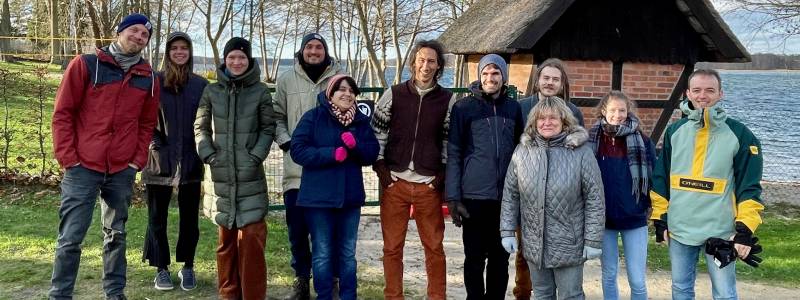
 | Dr. Philipp Norton Postdoc phone: +49-(0)30-2093-98407 email: philipp.norton  hu-berlin.de hu-berlin.de“It is a mistake to think you can solve any major problems just with potatoes.” |Douglas Adams |
BIOGRAPHY
Fascinated by the intricacies of animal behaviours, I began my academic career by studying communication in honeybees, bats and songbirds. In my PhD with Constance Scharff I focused on the development and production of temporal rhythms in learned animal vocalizations, particularly in the songs of zebra finches. Throughout these studies I became increasingly interested in the neurobiological mechanisms underlying these behaviours. This led me to my current project, in which I develop computational models to investigate how the representation of a learned song is formed and ultimately consolidated in the neural circuits of the songbird brain.
EDUCATION
2015 – 2018
Ph.D. in Biology at Freie Universität Berlin, Germany
2007 – 2014
B.Sc. & M.Sc. In Biology (Focus: Neurobiology and Behaviour) at Universität Rostock and Freie Universität Berlin, Germany
PUBLICATIONS
Norton P, Benichov JI, Pexirra M, Schreiber S, Vallentin D (2022): A feedforward inhibitory premotor circuit for auditory–vocal interactions in zebra finches, Proceedings of the National Academy of Sciences, 119(23), e2118448119. https://doi.org/10.1073/pnas.2118448119.
Pallasdies F, Norton P, Schleimer J-H, Schreiber S (2021): Neural optimization: Understanding trade-offs with Pareto theory, Current opinion in Neurobiology, 71, 84-91. https://doi.org/10.1016/j.conb.2021.08.008
Norton P, Barschke P, Scharff C, Mendoza E (2019): Differential Song Deficits after Lentivirus-Mediated Knockdown of FoxP1, FoxP2, or FoxP4 in Area X of Juvenile Zebra Finches, Journal of Neuroscience, 39(49), 9782-9796. https://doi.org/10.1523/JNEUROSCI.1250-19.2019
Burchardt L S, Norton P, Behr O, Scharff C, Knörnschild M (2019): General isochronous rhythm in echolocation calls and social vocalizations of the bat Saccopteryx bilineata., Royal Society Open Science, 6(181076). https://doi.org/10.1098/rsos.181076
Ravignani A*, Norton P* (2017): Measuring rhythmic complexity: A primer to quantify and compare temporal structure in speech, movement, and animal vocalizations., Journal of Language Evolution, 2(1), 4–19. https://doi.org/10.1093/jole/lzx002 *The authors contributed equally to this study
Norton P, Scharff C (2016): “Bird Song Metronomics“: Isochronous Organization of Zebra Finch Song Rhythm., Frontiers in Neuroscience, 10(309). https://doi.org/10.3389/fnins.2016.00309
Ullrich R, Norton P, Scharff C (2016): Waltzing Taeniopygia: integration of courtship song and dance in the Australian zebra finch., Animal Behaviour, 112, 285–300. https://doi.org/10.1016/j.anbehav.2015.11.012
Degen J, Kirbach A, Reiter L, Lehmann K, Norton P, Storms M, Koblofsky M, Winter S, Georgieva P B, Nguyen H, Chamkhi H, Meyer H, Singh P K, Manz G, Greggers U, Menzel R (2016): Honeybees Learn Landscape Features during Exploratory Orientation Flights., Current Biology, 26(20), 1–5. https://doi.org/10.1016/j.cub.2016.08.013
Degen J, Kirbach A, Reiter L, Lehmann K, Norton P, Storms M, Koblofsky M, Winter S, Georgieva P B, Nguyen H, Chamkhi H, Greggers U, Menzel R (2015): Exploratory behaviour of honeybees during orientation flights., Animal Behaviour, 102, 45–57. https://doi.org/10.1016/j.anbehav.2014.12.030
Menzel R, Kirbach A, Haass W D, Fischer B, Fuchs J, Koblofsky M, Lehmann K, Reiter L, Meyer H, Nguyen H, Jones S, Norton P, Greggers U (2011): A common frame of reference for learned and communicated vectors in honeybee navigation., Current Biology, 21(8), 645–650. https://doi.org/10.1016/j.cub.2011.02.039
